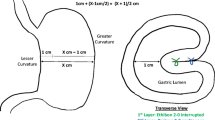Abstract
Background
The current indications for using a robotic technique in bariatric surgery remain unclear. The objective of this study was to quantify the safety and potential benefits of this novel technology as compared to the conventional laparoscopic approach.
Methods
A retrospective database of patients who underwent laparoscopic adjustable gastric banding (LAGB) between December 2006 and June 2009 was examined. During this period 407 consecutive patients underwent LAGB: 287 robotically and 120 conventionally. Patient demographics, operative complications, operating times, and clinical outcomes were examined.
Results
The patients in the robotic and conventional cohorts did not vary significantly in demographics. The prevalence of preoperative comorbidities was similar between the two groups. The rates of intraoperative and postoperative complications did not differ significantly between the two approaches. The length of postoperative hospital stay (1.3 ± 0.6 days for both approaches) and the operating time (91.5 ± 21.1 vs. 92.1 ± 30.9 min for robotic and conventional, respectively) did not differ significantly between the two approaches. However, for patients with a preoperative BMI ≥50 kg/m2 (n = 89, 64 robotic and 25 conventional), the operating time was significantly shorter using the robotic approach (91.3 ± 19.7 min for robotic vs. 101.3 ± 23.7 min for conventional, p = 0.04).
Conclusions
In this series, robotic and conventional approaches were similar in complication rates, operating time, and length of postoperative hospital stay. However, for patients with a preoperative BMI ≥50 kg/m2, the operating time is significantly shorter using the robotic approach despite the adoption of this new technique. These data suggest that the robotic approach is at least as safe as the conventional laparoscopic approach in LAGB, and that the robotic approach should be considered for gastric banding candidates with BMI ≥50 kg/m2.




Similar content being viewed by others
References
Buchwald H, Oien DM (2009) Metabolic/bariatric surgery worldwide 2008. Obes Surg 19:1605–1611
Mühlmann G, Klaus A, Kirchmayr W, Wykypiel H, Unger A, Höller E, Nehoda H, Aigner F, Weiss HG (2003) DaVinci robotic-assisted laparoscopic bariatric surgery: is it justified in a routine setting? Obes Surg 13:848–854
Cobourn C, Mumford D, Chapman MA, Wells L (2010) Laparoscopic gastric banding is safe in outpatient surgical centers. Obes Surg 20:415–422
Shashoua AR, Gill D, Locher SR (2009) Robotic-assisted total laparoscopic hysterectomy versus conventional total laparoscopic hysterectomy. JSLS 13:364–369
Steven D, Rostock T, Servatius H, Hoffman B, Drewitz I, Müllerleile K, Meinertz T, Willems S (2008) Robotic versus conventional ablation for common-type atrial flutter: a prospective randomized trial to evaluate the effectiveness of remote catheter navigation. Heart Rhythm 5:1556–1560
Breitenstein S, Nocito A, Puhan M, Held U, Weber M, Clavien PA (2008) Robotic-assisted versus laparoscopic cholecystectomy: outcome and cost analyses of case-matched control study. Ann Surg 247:987–993
Aron M, Koenig P, Kaouk JH, Nguyen MM, Desai MM, Gill IS (2008) Robotic and laparoscopic partial nephrectomy: a matched-pair comparison from a high-volume centre. BJU Int 102:86–92
Heemskerk J, de Hoog DE, van Gemert WG, Baeten CG, Greve JW, Bouvy ND (2007) Robot-assisted vs. conventional laparoscopic rectoplexy for rectal prolapse: a comparative study on costs and time. Dis Colon Rectum 50:1825–1830
Müller-Stich BP, Reiter MA, Wente MN, Bintintan VV, Köninger J, Büchler MW, Gutt CN (2007) Robot-assisted versus conventional laparoscopic fundoplication: short-term outcome of a pilot randomized controlled trial. Surg Endosc 21:1800–1805
Berryhill R Jr, Jhaveri J, Yadav J, Leung R, Rao S, El-Hakim A, Tewari A (2008) Robotic prostatectomy: a review of outcomes compared with laparoscopic and open approaches. Urology 72:15–23
Jacobsen G, Berger R, Horgan S (2003) The role of robotic surgery in morbid obesity. J Laparoendosc Adv Surg Tech 13:279–283
Ren CJ, Fielding GA (2003) Laparoscopic adjustable gastric banding: surgical technique. J Laparoendosc Adv Surg Tech 13:257–263
Magrina JF, Espada M, Munoz R, Noble BN, Kho RM (2009) Robotic adnexectomy compared with laparoscopy for adnexal mass. Obstet Gynecol 114:581–584
Bedient CE, Magrina JF, Noble BN, Kho RM (2009) Comparison of robotic and laparoscopic myomectomy. Am J Obstet Gynecol 201:566e1–566e5
Ballantyne GH, Belsley S, Stephens D, Saunders JK, Trivedi A, Ewing DR, Iannace V, Davis D, Capella RF, Wasielewski A, Moran S, Schmidt HJ (2008) Bariatric surgery: low mortality at a high-volume center. Obes Surg 18:660–667
Moser F, Horgan S (2004) Robotically assisted bariatric surgery. Am J Surg 188:38S–44S
Kuruba R, Koche L, Murr M (2007) Preoperative assessment and perioperative care of patients undergoing bariatric surgery. Med Clin North Am 91:339–351
Herman MP, Raman JD, Dong S (2007) Increasing body mass index negatively impacts outcomes following robotic radical prostatectomy. JSLS 11:438–442
Disclosures
Ms. Edelson and Drs. Dumon, Sonnad, Williams, and Shafi have no conflicts of interest or financial ties to disclose.
Author information
Authors and Affiliations
Corresponding author
Additional information
Presented at the 12th WCES, April 14--17, 2010, National Harbor, MD.
Rights and permissions
About this article
Cite this article
Edelson, P.K., Dumon, K.R., Sonnad, S.S. et al. Robotic vs. conventional laparoscopic gastric banding: a comparison of 407 cases. Surg Endosc 25, 1402–1408 (2011). https://doi.org/10.1007/s00464-010-1403-5
Received:
Accepted:
Published:
Issue Date:
DOI: https://doi.org/10.1007/s00464-010-1403-5



